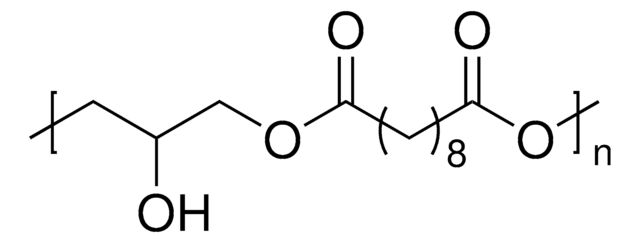84809
Sebacic acid
≥95.0% (GC)
Sinônimo(s):
Decanedioic acid
Faça loginpara ver os preços organizacionais e de contrato
About This Item
Fórmula linear:
HO2C(CH2)8CO2H
Número CAS:
Peso molecular:
202.25
Beilstein:
1210591
Número CE:
Número MDL:
Código UNSPSC:
12352100
ID de substância PubChem:
NACRES:
NA.22
Produtos recomendados
pressão de vapor
1 mmHg ( 183 °C)
Nível de qualidade
Ensaio
≥95.0% (GC)
p.e.
294.5 °C/100 mmHg (lit.)
pf
133-137 °C (lit.)
grupo funcional
carboxylic acid
cadeia de caracteres SMILES
OC(=O)CCCCCCCCC(O)=O
InChI
1S/C10H18O4/c11-9(12)7-5-3-1-2-4-6-8-10(13)14/h1-8H2,(H,11,12)(H,13,14)
chave InChI
CXMXRPHRNRROMY-UHFFFAOYSA-N
Procurando produtos similares? Visita Guia de comparação de produtos
Categorias relacionadas
Código de classe de armazenamento
11 - Combustible Solids
Classe de risco de água (WGK)
WGK 1
Ponto de fulgor (°F)
Not applicable
Ponto de fulgor (°C)
Not applicable
Equipamento de proteção individual
Eyeshields, Gloves, type N95 (US)
Escolha uma das versões mais recentes:
Já possui este produto?
Encontre a documentação dos produtos que você adquiriu recentemente na biblioteca de documentos.
Os clientes também visualizaram
Magdalena Kwiatkowska et al.
Polymers, 12(2) (2020-02-08)
In this work the preparation of polyamide 12 (PA12) based composites reinforced with pristine and surface-modified carbon nanotubes is reported. A qualitative and quantitative evaluation of multi-walled carbon nanotube functionalization with oxygen containing reactive groups achieved by different procedures of
Hyung-seok Park et al.
Acta biomaterialia, 8(8), 2911-2918 (2012-04-24)
High molecular weight biodegradable polyesters were prepared from sebacic acid, ethylene glycol and butylene glycol through a simple non-solvent polycondensation with a low toxicity catalyst. The successful synthesis of the polyesters was confirmed by gel permeation chromatography, (1)H-nuclear magnetic resonance
Christopher D Pritchard et al.
Biomaterials, 31(31), 7978-7984 (2010-07-27)
In retinal transplantation experiments it is hypothesized that remaining diseased photoreceptor cells in the host retina and inner retinal cells in transplants physically obstruct the development of graft-host neuronal contacts which are required for vision. Recently, we developed methods for
Senja K Lopac et al.
Journal of biomedical materials research. Part B, Applied biomaterials, 91(2), 938-947 (2009-07-31)
The release kinetics and stability of ovalbumin encapsulated into polyanhydride microspheres with varying chemistries were studied. Polymers based on the anhydride monomers sebacic acid (SA), 1,6-bis(p-carboxyphenoxy)hexane (CPH), and 1,8-bis (p-carboxyphenoxy)-3,6-dioxaoctane (CPTEG) were utilized. Microspheres were fabricated using two non-aqueous methods:
A Bertuzzi et al.
Biochemical pharmacology, 45(3), 697-702 (1993-02-09)
Sebacic (decanedioic) acid is a dicarboxylic acid proposed recently as an alternative energy substrate in total parenteral nutrition. In this paper, binding of sebacic acid to defatted human plasma albumin, also in the presence of decanoic acid, was studied by
Nossa equipe de cientistas tem experiência em todas as áreas de pesquisa, incluindo Life Sciences, ciência de materiais, síntese química, cromatografia, química analítica e muitas outras.
Entre em contato com a assistência técnica













